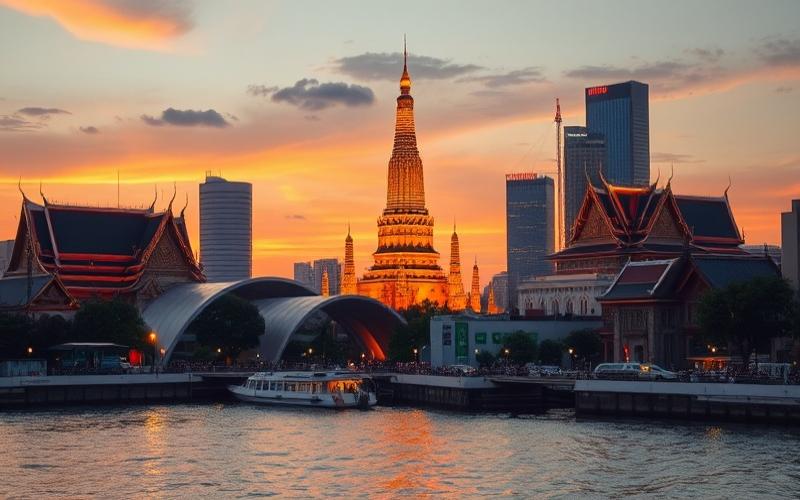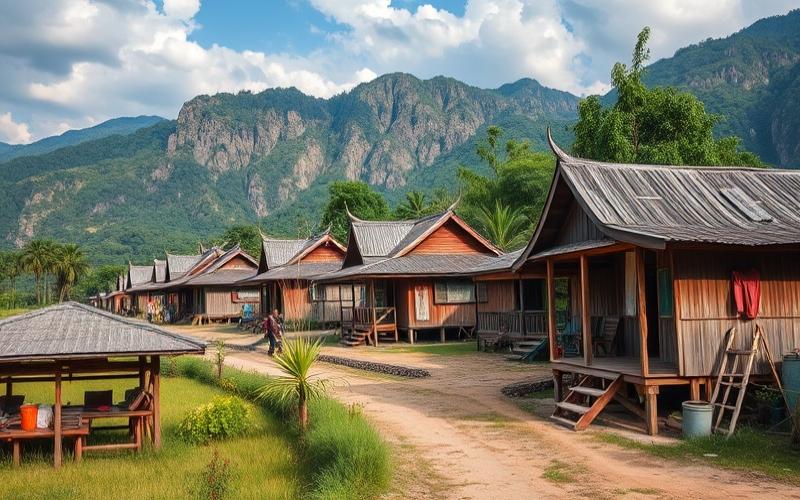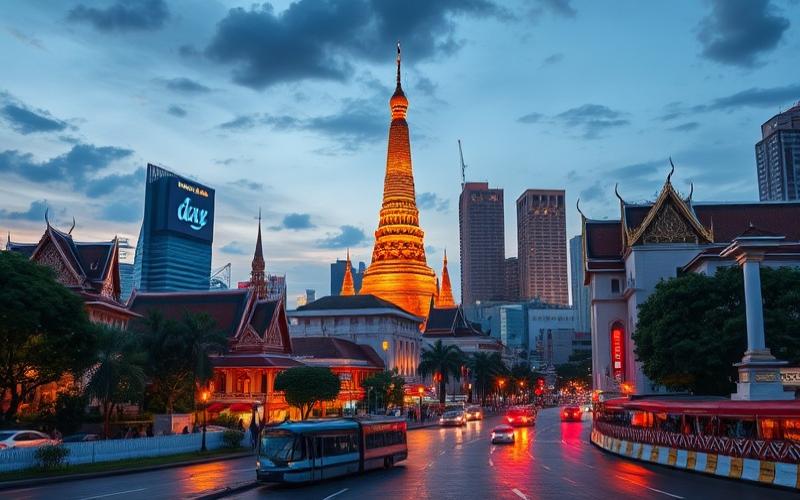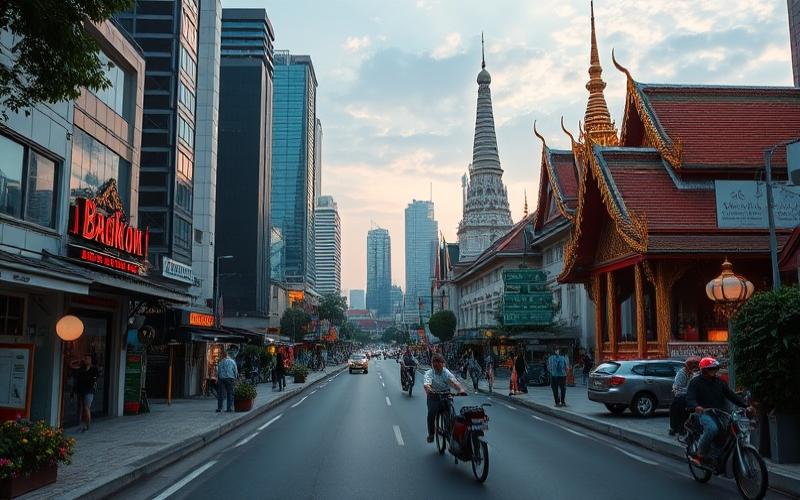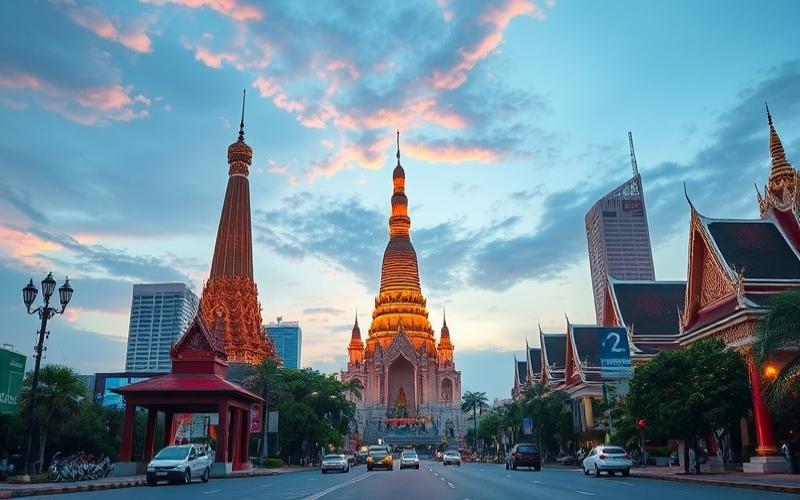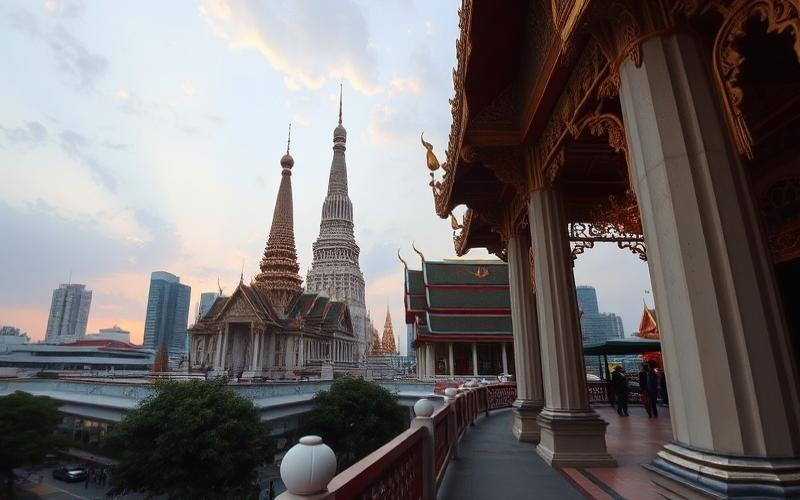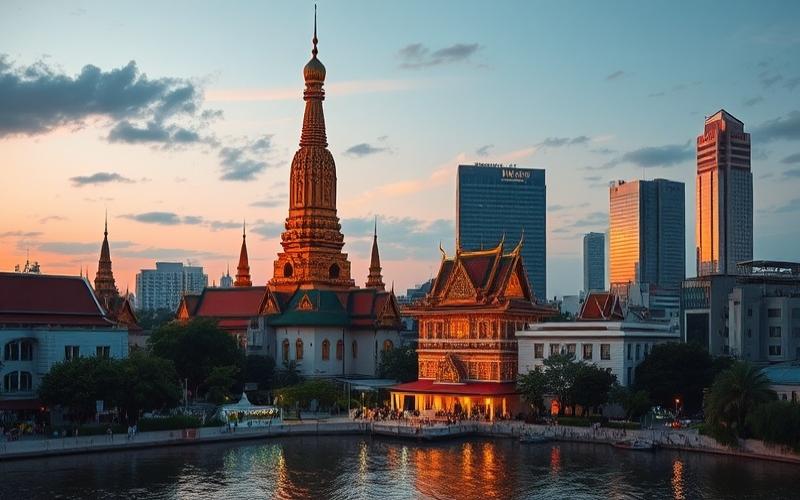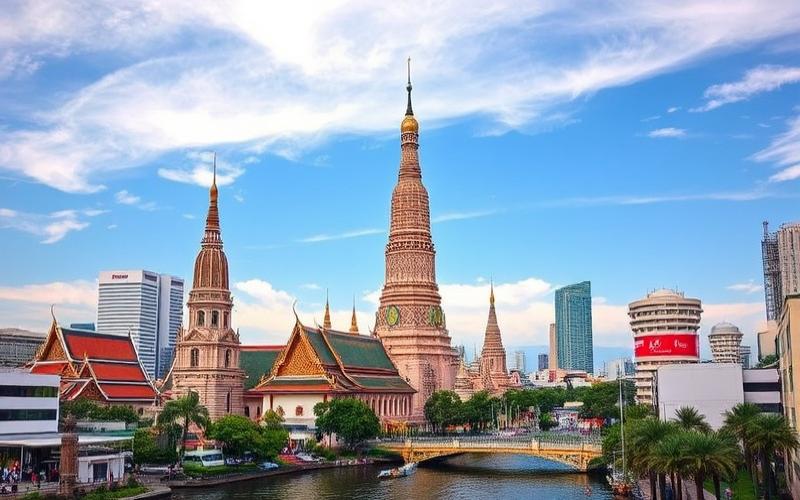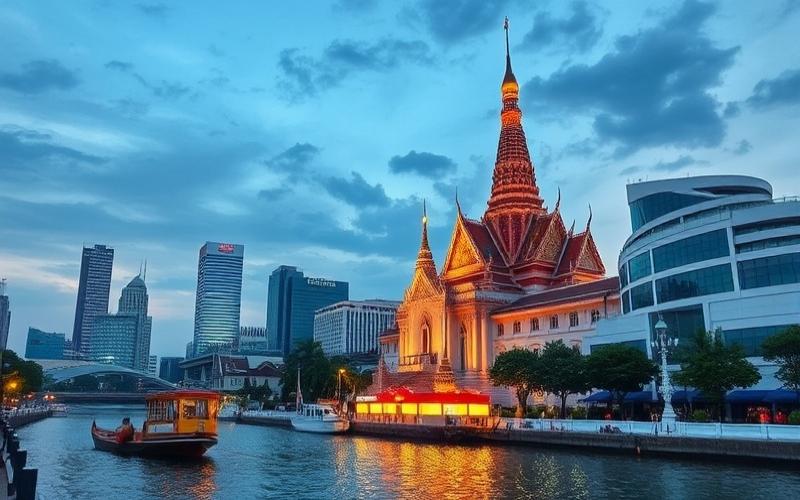
 Published on and written by Cyril Jarnias
Published on and written by Cyril Jarnias
In a context where rapid urbanization and rising real estate prices threaten housing accessibility, micro-apartments in Thailand are emerging as an effective solution for tight budgets. As urban centers like Bangkok become increasingly saturated, these ultra-compact dwellings enable residents to live in the heart of the city without breaking the bank.
Combining ingenious design with optimal space utilization, micro-apartments offer an attractive alternative for those seeking a convenient and affordable lifestyle. Let’s explore how this trend is not only transforming the urban landscape but also redefining expectations for modern housing.
Understanding the Micro-Apartment Concept in Thailand
Definition of Micro-Apartments
A micro-apartment is a self-contained one-room dwelling, often called a microflat, micro-condo, or micro-unit, designed to incorporate living space, sleeping area, bathroom, and kitchenette within 150 to 365 square feet. These homes may sometimes offer access to shared spaces, such as a communal kitchen or terrace. Foldable furniture, optimized storage, and compact appliances are common features to maximize space utilization.
Reasons for Micro-Apartments’ Popularity in Thailand
- Rapid urbanization: Population growth in major Thai cities like Bangkok has increased demand for affordable housing among young professionals, students, and low-income families.
- High real estate prices: The cost of traditional housing in urban centers has become prohibitive for many households, making micro-apartments attractive for living near workplaces or schools.
- Flexibility and practicality: Micro-apartments meet the needs of modern urban dwellers seeking affordable, well-located, and easy-to-maintain housing.
Socioeconomic Factors Driving Development
- Rising urban living costs: Rents and purchase prices for conventional housing are increasing, particularly in central neighborhoods and areas near transportation.
- Changes in family structure: The rise of single-parent families, singles, and young couples without children fuels demand for smaller spaces.
- Increased professional mobility: More workers are seeking temporary housing close to their jobs, making micro-apartments an appealing choice.
Recent Statistics on the Thai Market
| Year | Average Size (sq ft) | Market Growth Rate (%) | Average Monthly Price (THB) |
|---|---|---|---|
| 2022 | 215 – 323 | 12 | 8,000 – 12,000 |
| 2024 | 194 – 301 | 15 | 9,000 – 14,000 |
Micro-apartments now account for nearly 20% of new residential construction in Bangkok and other major Thai metropolitan areas.
Economic Benefits for Residents
- Reduced housing costs: Enables residence in central neighborhoods at affordable prices.
- Easier access to jobs and services: Proximity to transportation, schools, shopping centers, and urban infrastructure.
- Expense optimization: Lower rental fees, maintenance costs, and energy consumption.
Main Criticisms and Concerns
- Limited living space: Restricted square footage may compromise comfort, privacy, and quality of life, especially for families.
- Safety and health issues: Poor design or inadequate maintenance can increase risks of fire, unsanitary conditions, or overcrowding.
- Social isolation: Lack of common spaces or social interactions may heighten feelings of loneliness for some residents.
Visual Summary of Advantages and Disadvantages
| Advantages | Disadvantages |
|---|---|
| Reduced cost | Limited space |
| Central location | Risk of overcrowding |
| Low fees and maintenance | Sometimes limited comfort |
| Easy access to services | Potential safety issues |
Key takeaway:
Micro-apartments represent a pragmatic response to Thailand’s urban housing crisis, but they also raise essential questions about quality of life and safety.
Good to know:
Micro-apartments in Thailand are compact dwellings typically measuring between 215 and 323 square feet, gaining popularity due to rapid urbanization and high costs of traditional housing. This trend has strengthened in cities like Bangkok, where housing prices often exceed the means of young professionals and modest-income families. In 2023, an estimated 15% of new residential construction in Thai urban areas consists of micro-apartments, a figure that continues to rise. These homes allow residents to stay close to their workplaces while reducing housing-related expenses. However, the limited square footage raises concerns about quality of life and resident well-being, sometimes requiring significant compromises on space. Despite this, micro-apartments remain a practical solution for those seeking to live in well-connected neighborhoods while adhering to tight budgets.
Investing in Thai Studios: A Growing Market
Investments in Thai studios are experiencing strong growth, driven by major economic and demographic factors along with favorable government policies.
Economic and Demographic Factors Influencing the Market:
- Urban population growth, particularly in Bangkok, Phuket, and Chiang Mai, fueled by an influx of young professionals and expatriates seeking affordable, well-located housing.
- Rapid urbanization: The Thai population is increasingly concentrating in major cities, generating strong demand for compact, practical, and accessible residences.
- Rising cost of living and scarce urban land, which promote the growth of micro-apartments and studios prized for their financial accessibility and flexibility.
- Evolving lifestyles: Professional mobility, remote work, and the search for temporary housing solutions are boosting the popularity of functional small spaces.
Growing Popularity of Micro-Apartments:
Studios and micro-apartments meet the needs of young Thai professionals, expatriates, and investors looking for quick rental returns and simplified management.
These dwellings offer:
- Reduced entry price
- High liquidity in the secondary market
- Strong rental appeal in urban centers and near transportation infrastructure
| Factor | Impact on Studio/Micro-Apartment Demand |
|---|---|
| Urbanization | Rising urban population, need for compact housing |
| Young professionals | Preference for flexibility, proximity to jobs |
| Expatriates | Search for affordable, well-located solutions |
| Rising prices | Shift toward smaller, affordable spaces |
Government Policies Supporting Foreign Investment:
- Reduced transfer and mortgage registration fees to stimulate real estate purchases.
- Temporary relaxation of Loan-to-Value (LTV) rules facilitating credit access.
- Tax incentives and special programs to attract highly skilled foreigners and international investors.
- Promotion of new visas (e.g., “Smart Visa”) facilitating the settlement of foreign professionals in Thailand.
Urbanization Trends and Impact on Demand:
- New infrastructure projects (metro lines, roads) create attractive new residential hubs, particularly in suburban areas.
- Urbanization accompanies the development of vertical residential projects, with a growing share dedicated to studios and micro-housing.
- Developers are adapting their offerings to new needs: optimized spaces, shared amenities, connected services.
Growth Forecasts and Opportunities for Investors:
| Indicator | Key Data |
|---|---|
| 2024 Market Size | 54.01 billion USD |
| 2029 Forecast | 68.95 billion USD |
| Annual Growth Rate (CAGR) | 5% |
| Main Investors | China, Hong Kong, Singapore, Japan, United Kingdom |
| Support Policies | Tax relief, investment incentives |
Opportunities to Seize:
- Attractive rental yields in urban centers and high-density expatriate areas.
- High liquidity in the studio segment, facilitating resale.
- Diversification of real estate portfolios with exposure to Thai urban growth.
- Investments in projects near new transportation hubs or business districts.
Key takeaway: Studios and micro-apartments represent a direct response to current economic, demographic, and urban dynamics, offering investors—both foreign and local—privileged exposure to the sustained growth of the Thai real estate market.
Good to know:
In Thailand, the micro-apartment market is experiencing notable growth, stimulated by several economic and demographic factors. Young professionals and expatriates, seeking affordable and practical urban housing, are embracing these small units. Government policy also encourages foreign investment, particularly through favorable tax measures and a flexible regulatory framework for international buyers. The rapid pace of urbanization increases demand in expanding metropolises, while forecasts indicate continued growth in demand for these adaptable spaces in the coming years. For investors, both local and foreign, this trend represents a lucrative opportunity for development and return on investment, particularly in growing metropolitan areas like Bangkok and Chiang Mai.
How Microliving is Transforming Daily Life in Thailand
Living space in Thai micro-apartments is typically very limited, sometimes around 108 to 140 square feet per person. Residents adapt by prioritizing rigorous organization, reducing personal belongings, and adopting strict storage routines to optimize every available centimeter.
Smart Design and Modular Solutions
To maximize space utilization, smart design plays a key role. Apartments incorporate modular and multifunctional solutions:
- Foldable furniture (wall beds, drop-leaf tables)
- Integrated storage spaces (wall cabinets, under-bed drawers)
- Removable partitions or sliding doors allowing room transformation according to time of day
- Vertical utilization with ceiling-high shelves and mezzanines for sleeping or working
| Solution | Function | Main Advantage |
|---|---|---|
| Wall bed | Sleeping + daytime space | Space saving |
| Folding table | Meals + floor clearance | Versatility |
| Wall cabinet | Integrated storage | Volume optimization |
| Sliding door | Space separation/connection | Modularity and privacy |
Impact on Social Life
Microliving strongly influences social life. Common spaces, often present in newer buildings, become extensions of individual homes:
- Fitness rooms
- Lounge or coworking spaces
- Shared kitchens
- Common terraces
These areas promote neighborly exchanges, strengthen community feeling, and compensate for the lack of private space.
Financial Benefits
Financial benefits are significant for tenants:
- Lower rents than traditional apartments, enabling access to central or desirable neighborhoods.
- Reduced fees (electricity, water, maintenance).
- Fewer expenses on furniture and decor, with limited space requiring fewer purchases.
Challenges to Address
However, challenges remain:
- Limited storage, forcing choices and limiting accumulation of belongings.
- Lack of privacy, especially for couples or roommates, as separations are often visual but not acoustic.
- Difficulty hosting guests, with restricted space making gatherings or collective remote work challenging.
Cultural and Economic Trends
Microliving reflects contemporary Thailand’s cultural and economic trends:
- Rapid urbanization and rising land prices
- Growing popularity among young professionals and students, attracted by flexibility, urban location, and the possibility of living alone at lower cost
- Emergence of a minimalist lifestyle focused on experience and mobility rather than material possession
‣ Thus, microliving mirrors a changing urban society where spatial efficiency, architectural innovation, and community become priorities for a new generation of city dwellers.
Good to know:
In Thai micro-apartments, every square centimeter counts, requiring residents to optimize limited space through modular and multifunctional solutions such as wall beds and transformable furniture. This ingenious approach maximizes functionality in small spaces, following smart design that promotes compact lifestyles. The consequences for social life are notable, with increased use of common spaces to compensate for personal space deprivation, thereby stimulating community interactions among young professionals and students, the main adopters of this lifestyle. Financially, microliving offers significant reduction in housing expenses, making this option attractive for those seeking to minimize costs. However, challenges related to storage and privacy persist, requiring daily adaptation and management. In Thailand, microliving aligns with cultural and economic trends, reflecting a movement toward a more accessible, practical urban lifestyle in tune with the modern aspirations of a growing urban population.
Yield and Potential of Small Spaces by 2025
Potential of Micro-Apartments in Thailand by 2025
Micro-apartments represent an increasingly relevant solution in the context of Thailand’s 2025 real estate market, marked by rising prices in urban centers, growth in small households, and the search for affordable housing, particularly among young professionals and low-income families.
Real Estate Market Trends and Economic Developments
- Sustained increase in real estate prices in Bangkok and major cities, making homeownership difficult for first-time buyers.
- Growing demand for small spaces, particularly studios and one-bedroom apartments, linked to rising urban population and evolving lifestyles.
- Increasing interest from foreign investors, especially Asians, in compact units, with significant purchase volume for spaces under 430 square feet.
- Average 2025 rents for a Bangkok studio vary widely by standard, ranging from approximately 15,000 baht per month in the affordable segment to over 95,000 baht per month in the ultra-luxury segment.
Space Optimization, Energy Efficiency, and Comfort
- Use of open plans and multifunctional solutions to maximize functionality: wall beds, movable partitions, floor-to-ceiling integrated storage.
- Integration of compact appliances and smart home elements to control lighting, air conditioning, and electricity consumption.
- Panoramic windows and studied orientation to maximize natural light, reduce energy consumption, and improve psychological well-being.
- Enhanced ventilation systems and insulation to limit air conditioning needs in a tropical climate.
Interior Design Innovations and Functional Furniture
- Modular furniture: sofas convertible to beds, wall-mounted folding tables, built-in wardrobes with hideaway desks.
- Use of sustainable, easy-maintenance materials (engineered wood, composites, antibacterial surfaces).
- Optimized shared spaces in buildings: laundry rooms, fitness centers, community lounges, and green rooftops to compensate for reduced private unit size.
Comparison with Other Housing Types
| Housing Type | Average Monthly Rent (Bangkok, 2025) | Average Size | Appeal to Young Professionals | Appeal to Low-Income Families |
|---|---|---|---|---|
| Micro-apartment (studio, The future of micro-apartments in Thailand will depend on their ability to combine affordability, quality of life, and adaptability to the evolving needs of urban dwellers. |
Good to know:
By 2025, micro-apartments in Thailand could represent a viable and affordable solution to growing housing demand, supported by an expanding economy and urban trends favoring compact living spaces. Innovations in interior design and modular furniture optimize these reduced spaces by maximizing energy efficiency and resident comfort. Compared to other housing types, micro-apartments offer lower purchase costs and fees, making these dwellings particularly attractive to young professionals and low-income families. Growth in the micro-apartment market is anticipated, effectively responding to the need for affordable housing while incorporating practical and aesthetic solutions that enhance the viability and appeal of these units.
Disclaimer: The information provided on this website is for informational purposes only and does not constitute financial, legal, or professional advice. We encourage you to consult qualified experts before making any investment, real estate, or expatriation decisions. Although we strive to maintain up-to-date and accurate information, we do not guarantee the completeness, accuracy, or timeliness of the proposed content. As investment and expatriation involve risks, we disclaim any liability for potential losses or damages arising from the use of this site. Your use of this site confirms your acceptance of these terms and your understanding of the associated risks.







